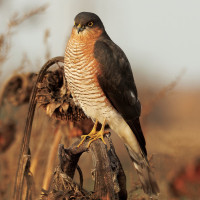Descrizione
The River Teign runs West to East through the Teign Gorge. The area has been described as the most beautiful walk on Dartmoor. This part of the deep gorge is heavily wooded and runs from Castle Drogo (National Trust) in the West to Fingle Bridge in the East. Castle Drogo is the last castle built in England (1930), Fingle Bridge was completed in the late 17th century. The area has three main paths, The Hunters Path and Fisherman's Path, both North of the river and the Forrester's Path South of the river. BE WARNED the Hunters Path is VERY STEEP in places, DO NOT ATTEMPT THIS PATH IN POOR WEATHER CONDITIONS AND ESPECIALLY IN LOW LIGHT LEVELS, THERE ARE HIGH DROP OFF POINTS. The Fisherman's Path alongside the river is mainly flat but can be very wet and has numerous tree roots making it challenging for the less able. The Forrester's Path is flat and a easy walk (PRESS STARS ON MAP FOR PATHS AND OTHER INFORMATION).
This site is further upstream of Dunsford Woods (see separate entry), and has many of the same bird species, so you can expect to see Merlo acquaiolo,Balia nera, Luì piccolo, Luì grosso, Ballerina gialla, Ballerina nera. Perhaps even Smergo maggiore can be seen on the river, though not as common here as at Dunsford Woods. At the top of the gorge Poiana, Gheppio, Corvo imperiale, Saltimpalo and Allodola are regularly seen.
Dettagli
Accesso
BE AWARE ROADS NEARING CASTLE DROGO AND FINGLE BRIDGE ARE VERY NARROW WITH LIMITED PASSING PLACES.
The A30 (North of Castle Drogo) runs from Okehampton in the West to Exeter in the East, from the A30 take the A382 signed Whiddon Down/Moretonhampstead, at the Hamlet of Sandy Park follow road signs to Castle Drogo.
From the City of Plymouth drive over Dartmoor on the B3212 to Moretonhampstead (via the Hamlet of Two Bridges), at Moretonhampstead turn onto A382 to the Hamlet of Sandy Park and follow signs to Castle Drogo.
For Fingle Bridge, if traveling from Exeter, on nearing Cheriton Bishop look for large road sign saying Cheriton Bishop/Crockernwell/Fingle Bridge and Tedburn St Mary, leave the A30 at this point and follow signs to Fingle Bridge.
For Fingle Bridge, if traveling from Okehampton on A30, nearing Whiddon Down take Left slip road at large sign saying Moretonhampstead/Torrington/Winkleigh and Services, almost immediately turn Right signed Crockernwell/Hittisleigh. Continue on this road (running parallel to A30), take the first Right turn signed Drewsteignton (road goes under the A30), continue straight on to Drewsteignton and follow road signs to Fingle Bridge.
Terreno e habitat
Foresta , Canyon/scogliera , Terreni coltivati , Città/paese , Fiume , Valle , Altopiano , Prateria/pascolo , Alberi e cespugli sparsiCaratteristiche dell’area
Terreno piano , Collinoso , Montagnoso , Paludoso , Scivoloso , RocciosoPercorso ad anello
SiÈ utile un cannocchiale?
Può essere utileBuona stagione per il BW
Tutto l'annoMiglior periodo per visitare
Inverno , Migrazione primaverile , Primavera , Autunno , Migrazione autunnalePercorso
Strada asfaltata , Strada sterrata , Sentiero strettoGrado di difficoltà del percorso a piedi
Difficoltà mediaModalità di accesso
A piedi , Bicicletta , MacchinaCapanno/torretta di osservazione
NoInformazioni aggiuntive
BE AWARE, the parking area just North of Fingle Bridge is for users of The Fingle Bridge Inn only. The parking area North of this (marked on map) can become very wet and muddy following prolonged periods of rain. There is a small National Trust car park on the South side of Fingle Bridge (NOT marked on map), the 'Packhorse' bridge is EXTREMELY NARROW.
During Summer months and at Weekends the area can get VERY BUSY, visiting outside these times might be best.
National Trust car parks are fee payable, also there is NO OVERNIGHT PARKING OR CAMPING.
The Fingle Bridge Inn 'beer garden' overlooking the river is good for feeding Ballerina gialla and Ballerina nera with a possibility of Martin pescatore and Merlo acquaiolo.


